Primrose-leaf Violet
Viola primulifolia L.
- Class
- Dicotyledoneae (Dicots)
- Family
- Violaceae (Violet Family)
- State Protection
- Threatened
Listed as Threatened by New York State: likely to become Endangered in the foreseeable future. For animals, taking, importation, transportation, or possession is prohibited, except under license or permit. For plants, removal or damage without the consent of the landowner is prohibited.
- Federal Protection
- Not Listed
- State Conservation Status Rank
- S2
Imperiled in New York - Very vulnerable to disappearing from New York due to rarity or other factors; typically 6 to 20 populations or locations in New York, very few individuals, very restricted range, few remaining acres (or miles of stream), and/or steep declines.
- Global Conservation Status Rank
- G5
Secure globally - Common in the world; widespread and abundant (but may be rare in some parts of its range).
Summary
Did you know?
The state's largest population of this beautiful white violet has less than 300 plants.
State Ranking Justification
There are 12 existing populations, but most are small in size with under 100 plants and growing in a small area. There are 21 historical occurrences known , but many of them have been developed or manipulated.
Short-term Trends
The short-term trend is unknown. Insufficient surveys have been done in recent years to determine short-term trends of existing populations.
Long-term Trends
The long-term trend is somewhat negative. There has been a moderate decline in the number of populations in the last 100 years, especially on Staten Island and western Long Island. Existing populations are small and many of them are unprotected so we can expect further decline in the future.
Conservation and Management
Threats
Since the species grows in successional openings of wet pine barrens it is most threatened by the loss of open canopied gaps as woody plants colonize these openings. Loss of habitat to residential and commercial development of these openings is also a threat.
Conservation Strategies and Management Practices
This species needs disturbance to reduce competition from woody plants and more aggressive herbaceous plants. However, too much direct disturbance to the plants will reduce or eliminate the population. Its habitat could be disturbed in the non-growing season to open it up for seed germination and colonization, but direct disturbance should be prevented during the growing season.
Research Needs
Research is needed to determine the optimal soil and habitat conditions for the growth of this species.
Habitat
Habitat
In New York Viola primulifolia has been found in open, wet or moist sites, including swamps, ditches, pond shores, sedge meadows and forest openings (New York Natural Heritage Program 2010). Moist, open meadows and stream banks, especially in sandy soil (Gleason and Cronquist 1991). Wet to dryish open shores, meadows, thin woods, etc. (Fernald 1970). Moist open meadows and along edges of streams, particularly in sandy soil (Russell 1965).
Associated Ecological Communities
- Coastal plain pond shore*
(guide)
The gently sloping shore of a coastal plain pond with seasonally and annually fluctuating water levels. Plants growing on the pond shore vary with water levels. In dry years when water levels are low there is often a dense growth of annual sedges, grasses, and herbs. Submerged and floating-leaved aquatic plants, such as fragrant waterlily and pondweeds, may become "stranded" on the exposed shore. In wet years when the water level is high only a few emergents and floating-leaved aquatics may be noticeable. T
- Pitch pine-oak-heath woodland
(guide)
A pine barrens community that occurs on well-drained, infertile, sandy soils. The structure of this community is intermediate between a shrub-savanna and a woodland. Pitch pine and white oak are the most abundant trees.
- Red maple-hardwood swamp
(guide)
A hardwood swamp that occurs in poorly drained depressions, usually on inorganic soils. Red maple is usually the most abundant canopy tree, but it can also be codominant with white, green, or black ash; white or slippery elm; yellow birch; and swamp white oak.
- Sedge meadow
(guide)
A wet meadow community that has organic soils (muck or fibrous peat). Soils are permanently saturated and seasonally flooded. The dominant herbs must be members of the sedge family, typically of the genus Carex.
* probable association but not confirmed.
Associated Species
- Carex
- Cyperus
- Eleocharis
- Euthamia caroliniana (slender flat-topped-goldenrod)
- Gratiola aurea (golden hedge-hyssop)
- Hypericum
- Kalmia angustifolia
- Lechea minor (thyme-leaved pinweed)
- Lobelia nuttallii (Nuttall's lobelia)
- Nymphaea odorata
- Phragmites australis (old world reed grass, old world phragmites)
- Rhynchospora capitellata (brownish beak sedge)
- Schizachyrium scoparium
- Schoenoplectus americanus (chair-maker's bulrush)
- Sphagnum
- Triadenum virginicum
- Xyris torta (slender yellow-eyed-grass)
Range
New York State Distribution
This violet is currently known from Staten Island and Suffolk and Nassau counties on Long Island. There are historical records west through New York City to Ulster and Sullivan counties. There is also a disjunct specimen from St. Lawrence County.
Global Distribution
This plant is present in all states east of the Mississippi River as well as Québec and Newfoundland in Canada. It extends west of the Mississippi in Iowa, Arkansas, Oklahoma, Louisiana, and Texas.
Identification Comments
General Description
Viola primulifolia is a perennial wildflower species growing from rhizomes and also producing short stolons late in the growing season. It is a "stemless" violet, meaning that the flowers are borne singly on leafless stalks emerging directly from the base of the plants. The leaves are 1.5 to 2.5 times as long as broad, subtruncate to cordate at the base, and the margins have small rounded teeth. The petals are white, the lower 3 with brownish-purple veins. The fruit are green capsules containing brown to black seeds (Rhoads and Block 2000, Haines 1998).
Best Life Stage for Proper Identification
The best time to identify this plant is when it is in flower but leaf characters can separate it from the two closely related species.
Similar Species
Viola primulifolia is closely related to V.macloskeyi and V. lanceolata, intermediate between the two species in form, and may hybridize with both. Leaf characters separate the three species: V. lanceolata's leaves are lance-shaped, at least 3 times as long as wide, and the teeth on their margins are tipped with tiny black glands, while V. macloskeyi's leaves are no more than 1.2 times as wide as long and distinctly cordate.
Best Time to See
Primrose-leaf Violet flowers from May through early June, and the fruits may persist into September.
- Vegetative
- Flowering
- Fruiting
The time of year you would expect to find Primrose-leaf Violet vegetative, flowering, and fruiting in New York.
Primrose-leaf Violet Images
Taxonomy
Primrose-leaf Violet
Viola primulifolia L.
- Kingdom Plantae
- Phylum Anthophyta
- Class Dicotyledoneae
(Dicots)
- Order Violales
- Family Violaceae (Violet Family)
- Order Violales
- Class Dicotyledoneae
(Dicots)
- Phylum Anthophyta
Synonyms
- Viola primulifolia var. acuta (Bigelow) Torr. & A. Gray
Additional Resources
Best Identification Reference
Gleason, Henry A. and A. Cronquist. 1991. Manual of Vascular Plants of Northeastern United States and Adjacent Canada. The New York Botanical Garden, Bronx, New York. 910 pp.
Other References
Fernald, M.L. 1950. Gray's manual of botany. 8th edition. D. Van Nostrand, New York. 1632 pp.
Holmgren, Noel. 1998. The Illustrated Companion to Gleason and Cronquist's Manual. Illustrations of the Vascular Plants of Northeastern United States and Adjacent Canada. The New York Botanical Garden, Bronx, New York.
Mitchell, Richard S. and Gordon C. Tucker. 1997. Revised Checklist of New York State Plants. Contributions to a Flora of New York State. Checklist IV. Bulletin No. 490. New York State Museum. Albany, NY. 400 pp.
New York Natural Heritage Program. 2010. Biotics database. New York Natural Heritage Program. New York State Department of Environmental Conservation. Albany, NY.
New York Natural Heritage Program. 2024. New York Natural Heritage Program Databases. Albany, NY.
Russell, Norman H. (1965). Violets (Viola) of central and eastern United States: An introductory survey. Sida 2(1):1-113.
Weldy, T. and D. Werier. 2010. New York flora atlas. [S.M. Landry, K.N. Campbell, and L.D. Mabe (original application development), Florida Center for Community Design and Research http://www.fccdr.usf.edu/. University of South Florida http://www.usf.edu/]. New York Flora Association http://newyork.plantatlas.usf.edu/, Albany, New York
Links
About This Guide
This guide was authored by: Richard M. Ring
Information for this guide was last updated on: September 6, 2012
Please cite this page as:
New York Natural Heritage Program. 2024.
Online Conservation Guide for
Viola primulifolia.
Available from: https://guides.nynhp.org/primrose-leaf-violet/.
Accessed July 27, 2024.


